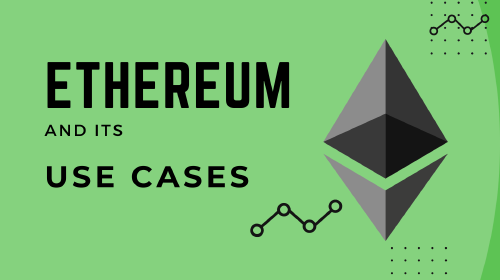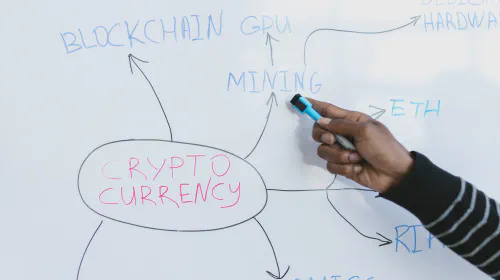How Do Ethereum Nodes Communicate?
Salomon Kisters
Jan 26, 2023This post may contain affiliate links. If you use these links to buy something we may earn a commission. Thanks!
Ethereum nodes are vital components of the Ethereum network. They are responsible for processing, verifying, and executing transactions on the blockchain. Ethereum nodes communicate with each to ensure the network operates efficiently and securely.
Ethereum was born out of a need to address the problems of its predecessors. Crypto mining was widely criticized due to the drawbacks inherent in the Proof-of-Work (PoW) consensus, such as high levels of energy consumption, low scalability, and growing hardware requirements.
These drawbacks trace back to the earliest blockchains, most notably Bitcoin.
Ethereum’s Switch to Proof-of-Stake
Ethereum was a PoW blockchain at the time of its release, but the developers were constantly working on a new way to make rewarding cryptocurrency more efficient. Proof-of-Stake consensus – a protocol designed around efficiency – was developed as an alternative to PoW mining.
To achieve this, the developers launched the Beacon side chain in December 2020. That meant that Ethereum nodes had to operate between two blockchains. The original chain was a PoW blockchain. The Beacon chain, on the other hand, followed the PoS mechanism.
When a transaction is sent to the Ethereum network, all of the nodes on the network receive it. Each node then verifies the information and determines whether or not the transaction should be added to the blockchain. If it is determined to be valid, the node will send the information to its peers, which will all then verify the information.
Once the majority of the nodes have verified the data, it is added to the blockchain and the transaction is completed. Ethereum nodes also communicate with each other when updating the network or when trying to reach a consensus on how to handle a particular transaction. This is done through a process called “gossiping,” in which nodes exchange information with each other about the state of the network.
As the Ethereum network continues to evolve and grow, the role of the nodes becomes even more important. They are the backbone of the network and are essential for keeping it secure and reliable.
In September 2022, the Ethereum blockchain merge was completed. There are no 2 separate chains on the Ethereum mainnet. This event marked the end of the PoW Ethereum consensus and the beginning of a complete Proof-of-Stake mechanism for rewarding gas. We will now explain how the Ethereum nodes work.
What is a Consensus Mechanism?
In simple terms, a consensus mechanism is a means for all computers to come to an agreement over the fate of a transaction. It includes the entire technology stack of protocols, ideas, and algorithms that enable the network nodes to agree on the state of the blockchain. So in other words, the type of consensus mechanism determines the way nodes communicate with each other.
There’s more than one way to achieve consensus on a blockchain. However, the most common ones are PoW and PoS. We have covered several consensus mechanisms in detail in one of our previous articles.
Note that the ‘consensus mechanism’ is different from ‘consensus’, which refers to the state of agreement between nodes. In Ethereum, a consensus is achieved when 66% of the nodes agree on the global state of the blockchain network. We also call this a formalized consensus.
What Happened in the Ethereum Merge?
The first phase of the transition to a PoS model involved a new blockchain. The Beacon chain operated off the Ethereum mainnet that contained all Ethereum accounts, balances, smart contracts, and blockchain state data. It was dubbed Ethereum 2.0 or Eth2, while the original Ethereum chain was called Eth1.
The parallel chain had a different set of nodes called beacon nodes. Consequently, the nodes had to exchange data with each other. Ethereum developers planned to conduct a phased rollout of the changes and eventually get the blockchain to work on one chain but with two layers. The phased transition ensured that all bugs were tested before the release build was deployed and there was no loss of transaction data.
The beacon chain powered a new ‘consensus engine’ which was supposed to manage the nodes run by stakers. Any transactions conducted by stakers were stored on a separate ledger without PoW mining.
Stakers put ETH funds into the blockchain in exchange for the ability to validate transactions and add blocks to the chain. Validators that act dishonestly or lazily are at the risk of losing their staked ETH. This is the basis of the Ethereum smart contract. The blockchain will reward gas to each validator based on the amount of staked ETH funds.
When the merge was completed in 2022, the network stopped offering PoW rewards. Only consensus nodes on the Eth2 chain would receive rewards. Consequently, the nodes operating each layer were renamed as execution layer clients (formerly Eth1) and consensus layer clients (formerly Eth2).
These changes are also setting up Ethereum to implement sharding, which is a method of generating extra side chains to spread data horizontally across clients. Sharding will allow users to save memory data while speeding up on-chain transactions.
What are the Benefits of the Ethereum Merge?
The merging of the two chains into one blockchain allows Ethereum the full advantages of PoS consensus.
- Energy Efficiency: There is no need for power-hungry computers to quickly solve hash puzzles.
- Low Entry Barriers: Since Ethereum will work on any type of computer, users can join the blockchain with budget computers or mobile devices.
- More Decentralized Operations: There is less reliance on a small group of computers to run the network.
- Security: Penalties for nodes working in bad faith make 51% attacks harder. This synergizes with improved decentralization.
- More Room for Social Recovery Methods: Ethereum stakers will be able to respond promptly in case of a malicious attack on the network.
Types of Ethereum Nodes
Like any blockchain, Ethereum requires nodes to work. In Ethereum, the node is basically a virtual instance running on an Ethereum software client. There are three different types of Ethereum nodes.
1. Full Nodes
- These maintain the complete transaction record of the blockchain, which is stored locally.
- They validate all transactions and maintain the Ethereum state record.
- They are responsible for ensuring that smart contracts are functioning properly.
- Checks the compliance of incoming transactions with current Ethereum standards specifications.
2. Archive Nodes
- These are full nodes but with an ‘archive’ option switched on. This option keeps a complete record of transactions, starting right from the genesis block.
- They are used when any data before the previous 128 blocks is needed for validation.
- They are used when users execute historical query functions.
- They require significantly more disk space than Ethereum full nodes.
3. Light Node
- Light nodes do not store the complete transaction record or Ethereum state.
- It focuses on the block header.
- Requires light hardware and minimum skill to operate. For this reason, these nodes are ideal for newcomers who want to create an ETH wallet.
- Relies on full nodes to fetch information.
Ethereum Clients
Ethereum nodes communicate with each other through software implementations known as Ethereum clients. There are two basic types of clients.
1. Execution of Client
The Execution client listens to new transactions broadcasted in the Ethereum network and executes them in Ethereum Virtual Machine (EVM). This client holds the latest state value and all current Ethereum data. It is like a database store.
2. The Consensus Client
The Consensus client implements the PoS consensus algorithm. This enables the network to achieve a state of agreement based on validations from the execution clients.
Before the merge, execution clients could be operated separately. It is not possible to do this anymore. Ethereum developers have specified standards for clients to follow when communicating with the network. Therefore, Ethereum clients can be programmed in any language as long as these standards are met.
This has resulted in a diverse ecosystem of interoperable clients and decentralized apps (dApps). Ethereum developers have made clients in several languages like Geth, OpenEthereum, Erigon, Nethermind, and Besu.
How Do Ethereum Validators Work?
Ethereum uses 3 pieces of software for validating transactions: an execution client, a consensus client, and a validator. A validator is a software instance activated once the user pools 32 ETH from their wallet. This will put them into an activation queue.
After activation, validators receive new blocks from other users (also called peers) on the Ethereum network. Validators re-execute the transactions and check the signature data. If the transaction is valid, the node sends a vote (an ‘attestation’) for it to the Ethereum network.
In Ethereum, the time for adding a transaction into a block is fixed. 12 seconds fit into 1 slot and 32 slots make 1 epoch. Ethereum randomly selects 1 validator as a block proposer in every slot.
This validator is responsible for creating a new block and broadcasting it to other nodes. For every slot, the system randomly chooses a committee of validators, whose votes are used to check the validity of the block being proposed.
If all validating nodes are online and functional, there would be 1 block formed in every slot. This means block time is 12 seconds. In reality, this is not possible, as some nodes are bound to be offline, forcing the network to look for eligible votes.
Transactions that are recorded into blocks require gas fees. Once the transactions are recorded, the validator keeps a portion of the gas used in the transaction.
Conclusion
The 3 types of Ethereum nodes require 3 pieces of software to implement PoS algorithms, running on a 2-layer blockchain platform. The removal of PoW mining has paved the way for a voting system that moves closer toward a fully decentralized mode of operation.
The PoS consensus mechanism is more energy efficient and adds an additional layer of security to the network. While the practice of mining crypto coins is still alive, staking has become an increasingly popular way to reward users.
Stay informed with the latest insights in Crypto, Blockchain, and Cyber-Security! Subscribe to our newsletter now to receive exclusive updates, expert analyses, and current developments directly to your inbox. Don't miss the opportunity to expand your knowledge and stay up-to-date.
Love what you're reading? Subscribe for top stories in Crypto, Blockchain, and Cyber-Security. Stay informed with exclusive updates.
Please note that the Content may have been generated with the Help of AI. The editorial content of OriginStamp AG does not constitute a recommendation for investment or purchase advice. In principle, an investment can also lead to a total loss. Therefore, please seek advice before making an investment decision.

Who Runs Ethereum? Understanding Decentralized Governance
Ethereum has a decentralized governance model, with stakeholders like Ether holders, developers, and miners contributing to decision-making.

Ethereum: Decentralized Blockchain Platform & Use Cases
Learn about Ethereum, a decentralized blockchain platform with smart contract functionality. Explore its use cases, how to buy Ether, and the benefits of OriginStamp.

What Is Ethereum Classic, and Does It Have a Future?
Most people confuse Ethereum and Ethereum Classic to be the same thing. They are not.
Protect your documents
Your gateway to unforgeable data. Imprint the authenticity of your information with our blockchain timestamp